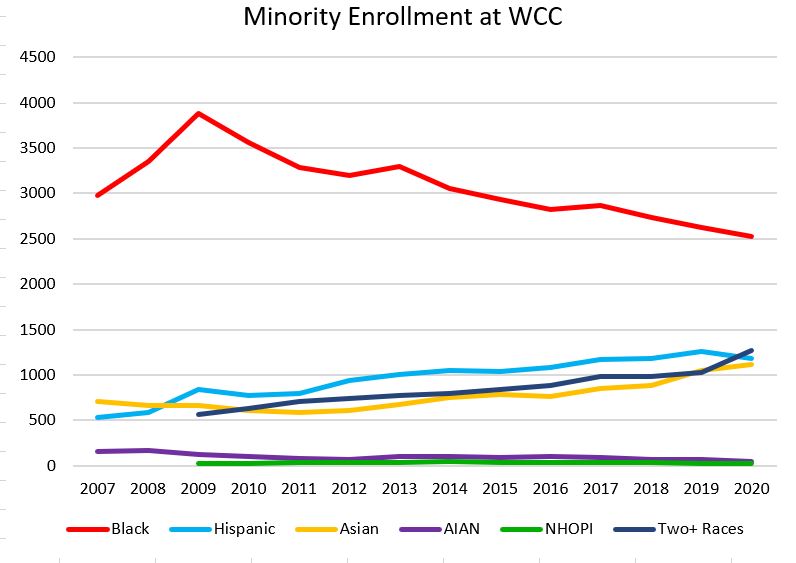This week, the news cycle has focused on the Supreme Court ruling that gutted Affirmative Action as it relates to selective college admissions criteria. Technically, the ruling applies to all colleges and universities, but it has little practical effect on Washtenaw Community College. WCC has a non-selective admissions process, so virtually anyone who meets the age requirements can attend classes. The ruling should not change Black student enrollment – or enrollment by all other minority students – at all.
But that does not mean the issue of minority enrollment at WCC is moot. The US Department of Education requires colleges and universities to collect and report race- and gender-based enrollment data as part of its broader data collection efforts.
WCC – like all other colleges and universities that accept federal funding – collects and reports these data annually. Regarding race-based attendance data, schools classify students using the following categories:
- American Indian/Alaska Native
- Asian
- Black
- Hawaiian Native/Other Pacific Islander
- Hispanic
- Two or more races
- White
- Race Unknown
Schools also report “Non-Resident Alien” attendance, but that’s not really a racially identifying characteristic.
The Supreme Court’s decision regarding race-based admission has raised profound concerns about the ability of non-white students to access selective higher education institutions. But there is another, equally profound concern evolving at non-selective institutions, like WCC.
Black student enrollment at WCC peaked in 2010 at 3,880. This figure includes both degree-seeking and non-degree seeking students. Except for small increases of fewer than 100 students in 2014 and 2018, black student enrollment has declined in every subsequent year. To characterize the problem, in 2021, black student enrollment was 35% lower than it was in 2010.
With the exception of enrollments by students classified as American Indians/Alaskan Natives and Native Hawaiian/Other Pacific Islanders, enrollment by other racial minorities is not decreasing.
Why is Black student enrollment dropping?
Other minority enrollment is likely increasing for two reasons. First, the US Department of Education has refined its data collection practices in recent years, so students have a wider variety of options when reporting their race. Second, certain minority populations have grown in Washtenaw County in the last decade and a half. The number of these students enrolled at WCC may have risen because the minority population has increased.
Neither of those statements apply to Black students. The Black population in Washtenaw County has not declined, and while it is possible that students who previously might have identified themselves as Black now identify themselves as being of two or more races, this doesn’t account for the decrease in Black student enrollment.
Further, this isn’t a circumstance that is unique to WCC. According to a recent report from the Lumina Foundation, black student enrollment at the nation’s community colleges has declined by 300,000 in the last decade.
Rather, Black students are likely abandoning community colleges because in practice, Black workers are paid less than their White counterparts in the workforce. Community college degrees and non-degree certificates, which already produce nominal economic gains for workers regardless of race, produce virtually no added income beyond that of a high school diploma for the lowest-compensated workers.
Tomorrow, I will look at when and where community college degrees have lost value, and why it is important to correct this.























